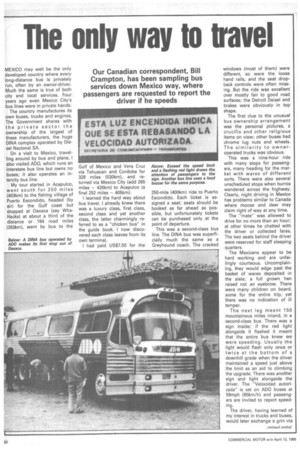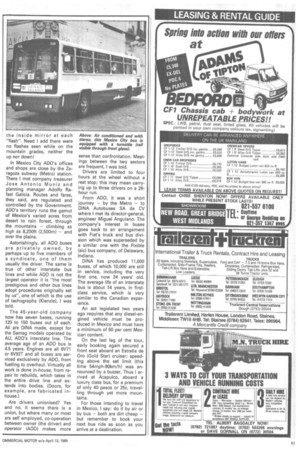The only way to travel
Page 52

Page 53

If you've noticed an error in this article please click here to report it so we can fix it.
Our Canadian correspondent, Bill Crampton, has been sampling bus services down Mexico way, where passengers are requested to report the driver if he speeds
ESTA LUZ ENCENDIOA INDICA OUE SE ESTA REBASANDO LA VELOCIDAD AUTORIZADA.
camtAttnA COIALINoCarronootio too-Art*14mm*
MEXICO may well be the only developed country where every long-distance bus is privately run, often by an owner-driver. Much the same is true of both city and local services. Four years ago even Mexico City's bus lines were in private hands. The country manufactures its own buses, trucks and engines. The Government shares with the private sector the ownership of the largest of these manufacturers, the huge DINA complex operated by Diesel Nacional SA.
On a visit to Mexico, travelling around by bus and plane. I also visited ADO, which runs an interstate bus line but owns no buses; it also operates an intercity bus line.
My tour started in Acapulco, went south for 250 miles (403km) to the fishing village of Puerto Escondido, headed (by air) for the Gulf coast but stopped at Oaxaca (say WhaHacka) at about a third of the distance or 164 road miles (263km), went by bus to the Gulf of Mexico and Vera Cruz via Tehuacan and Cordoba for 329 miles (530km), and returned via Mexico City (add 265 miles — 426km) to Acapulco (a final 252 miles — 405km).
I learned the hard way about bus travel. I already knew there was a luxury class, first class, second class and yet another class, the latter charmingly referred to as a "chicken bus" in the guide book. I now discovered each class leaves from its own terminal.
I had paid US$7.50 for the 250-mile (400km) ride to Puerto Escondido. Each ticket is assigned a seat; seats should be booked as far ahead as possible, but unfortunately tickets can be purchased only at the point of departure. • This was a second-class bus line. The DINA bus was superficially much the same as a Greyhound coach. The cracked windows (most of them) were different, so were the loose hand rails, and the seat dropback controls were often missing. But the ride was excellent over mostly fair to good road surfaces; the Detroit Deisel and brakes were obviously in top shape.
The first clue to the unusual bus ownership arrangement was the personal pictures, a crucifix and other religious items on view; other buses had chrome lug nuts and wheels. The similarity to owneroperated trucks was obvious.
This was a nine-hour ride with many stops for passengers, many heading for the market with wares of different sorts. There were also several unscheduled stops when burros wandered across the highway. Clearly, night driving in Mexico has problems similar to Canada where moose and deer may claim right of way at any time.
The "mate" was allowed to drive for no more than an hour; at other times he chatted with the driver or collected fares. The two seats behind the driver were reserved for staff sleeping quarters.
The Mexicans appear to be hard working and are unfailingly courteous. Uncomplaining, they would edge past the basket of wares deposited in the aisle; a full grown hen raised not an eyebrow. There were many children on board, some for the entire trip, yet there was no indication of ill temper.
The next leg meant 150 mountainous miles inland, in a second-class bus. There was a sign inside; if the red light alongside it flashed it meant that the entire bus knew we were speeding. Usually the light would flash only once or twice at the bottom of a downhill grade when the driver maintained a speed just above the limit as an aid to climbing the upgrade. There was another sign and light alongside the driver. The "Velocidad autorizada" is set on ADO buses at 59mph (95km/h) and passengers are invited to report speeding.
The driver, having learned of my interest in trucks and buses, would later exchange a grin via
the inside mirror at each "flash". Need I add there were no flashes seen while on the mountain grades, neither the up nor down!
In Mexico City ADO's offices and shops are close by the Zaragoza subway (Metro) station. There I met company treasurer Jose Antonio Muniz and planning manager Adolfo Rafael Galicia. Routes and fares, they said, are regulated and controlled by the Government. ADO's territory runs the gamut of Mexico's varied acres from desert to rain forest, through the mountains — climbing as high as 8,200ft (2,500m) — and over the plains.
Astonishingly, all ADO buses are privately owned, by perhaps up to five members of a syndicate, one of them usually the driver. The same is true of other interstate bus lines and while ADO is not the largest operator it is "the most prestigious and other bus lines adopt procedures originally set by us", one of which is the use of tachographs (Kienzle), I was told.
The 45-year-old company now has seven bases, running 120 to 150 buses out of each. All are DINA made, except for the Samag models operated by AU, ADO's interstate line. The average age of an ADO bus is 4.5 years. Engines are all 8V71 or 6V92T and all buses are serviced exclusively by ADO, from fuelling to overhaul. Virtually all work is done in-house, from repair to rebuilds, which takes in the entire drive line and extends into bodies. (Doors, for example, are fabricated inhouse.) Are drivers unionised? Yes and no. It seems there is a union, but where many or most ars self employed, co-operation between owner (the driver) and operator (ADO) makes more
sense than confrontation. Meetings between the two sectors are frequent, I was told.
Drivers are limited to four hours at the wheel without a' rest stop; this may mean carry ing up to three drivers on a 26-* hour run.
From ADO, it was a short journey — by the Metro — to DINA Autobuses SA de CV where I met its director-general, engineer Miguel Anguiano. The company's interest in buses goes back to an arrangement with Fiat's truck and bus division which was superseded by a similar one with the Flxible (sic) bus company, of Delaware, Indiana.
DINA has produced 11,000 buses, of which 10,000 are still in service, including the very first one, now 24 years' old.
The average life of an interstate bus is about 14 years, in firstclass service, which is very similar to the Canadian exper ience.
An act legislated two years ago requires that any diesel-engined vehicle must be produced in Mexico and must have a minimum of 60 per cent Mex ican content.
On the last leg of the tour,
early booking again secured a front seat aboard an Estrella de Oro (Gold Star) cruiser; speeding above the set limit (this time 54mph-90km/h) was announced by a buzzer. Thus I arrived at Acapulco, aboard a luxury class bus, for a premium of only 40 pesos or 25c, travelling through yet more moun
tains.
For those intending to travel in Mexico, I say: do it by air or by bus — both are dirt cheap — but remember to book your next bus ride as soon as you arrive at a destination.




















































































